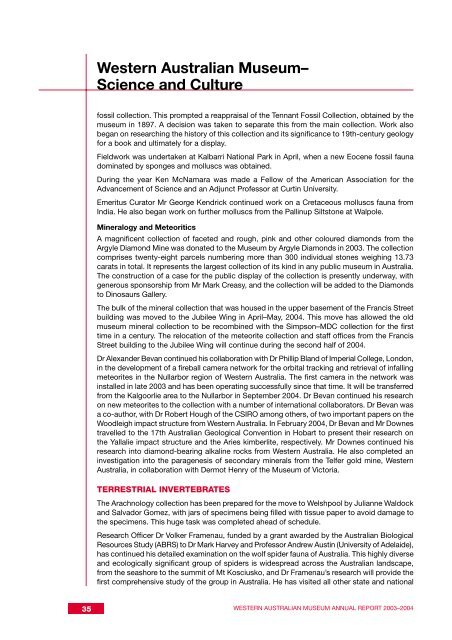Western Australian Museum Annual Report 2003-2004
Western Australian Museum Annual Report 2003-2004
Western Australian Museum Annual Report 2003-2004
You also want an ePaper? Increase the reach of your titles
YUMPU automatically turns print PDFs into web optimized ePapers that Google loves.
35<br />
<strong>Western</strong> <strong>Australian</strong> <strong>Museum</strong>–<br />
Science and Culture<br />
fossil collection. This prompted a reappraisal of the Tennant Fossil Collection, obtained by the<br />
museum in 1897. A decision was taken to separate this from the main collection. Work also<br />
began on researching the history of this collection and its significance to 19th-century geology<br />
for a book and ultimately for a display.<br />
Fieldwork was undertaken at Kalbarri National Park in April, when a new Eocene fossil fauna<br />
dominated by sponges and molluscs was obtained.<br />
During the year Ken McNamara was made a Fellow of the American Association for the<br />
Advancement of Science and an Adjunct Professor at Curtin University.<br />
Emeritus Curator Mr George Kendrick continued work on a Cretaceous molluscs fauna from<br />
India. He also began work on further molluscs from the Pallinup Siltstone at Walpole.<br />
Mineralogy and Meteoritics<br />
A magnificent collection of faceted and rough, pink and other coloured diamonds from the<br />
Argyle Diamond Mine was donated to the <strong>Museum</strong> by Argyle Diamonds in <strong>2003</strong>. The collection<br />
comprises twenty-eight parcels numbering more than 300 individual stones weighing 13.73<br />
carats in total. It represents the largest collection of its kind in any public museum in Australia.<br />
The construction of a case for the public display of the collection is presently underway, with<br />
generous sponsorship from Mr Mark Creasy, and the collection will be added to the Diamonds<br />
to Dinosaurs Gallery.<br />
The bulk of the mineral collection that was housed in the upper basement of the Francis Street<br />
building was moved to the Jubilee Wing in April–May, <strong>2004</strong>. This move has allowed the old<br />
museum mineral collection to be recombined with the Simpson–MDC collection for the first<br />
time in a century. The relocation of the meteorite collection and staff offices from the Francis<br />
Street building to the Jubilee Wing will continue during the second half of <strong>2004</strong>.<br />
Dr Alexander Bevan continued his collaboration with Dr Phillip Bland of Imperial College, London,<br />
in the development of a fireball camera network for the orbital tracking and retrieval of infalling<br />
meteorites in the Nullarbor region of <strong>Western</strong> Australia. The first camera in the network was<br />
installed in late <strong>2003</strong> and has been operating successfully since that time. It will be transferred<br />
from the Kalgoorlie area to the Nullarbor in September <strong>2004</strong>. Dr Bevan continued his research<br />
on new meteorites to the collection with a number of international collaborators. Dr Bevan was<br />
a co-author, with Dr Robert Hough of the CSIRO among others, of two important papers on the<br />
Woodleigh impact structure from <strong>Western</strong> Australia. In February <strong>2004</strong>, Dr Bevan and Mr Downes<br />
travelled to the 17th <strong>Australian</strong> Geological Convention in Hobart to present their research on<br />
the Yallalie impact structure and the Aries kimberlite, respectively. Mr Downes continued his<br />
research into diamond-bearing alkaline rocks from <strong>Western</strong> Australia. He also completed an<br />
investigation into the paragenesis of secondary minerals from the Telfer gold mine, <strong>Western</strong><br />
Australia, in collaboration with Dermot Henry of the <strong>Museum</strong> of Victoria.<br />
TERRESTRIAL INVERTEBRATES<br />
The Arachnology collection has been prepared for the move to Welshpool by Julianne Waldock<br />
and Salvador Gomez, with jars of specimens being filled with tissue paper to avoid damage to<br />
the specimens. This huge task was completed ahead of schedule.<br />
Research Officer Dr Volker Framenau, funded by a grant awarded by the <strong>Australian</strong> Biological<br />
Resources Study (ABRS) to Dr Mark Harvey and Professor Andrew Austin (University of Adelaide),<br />
has continued his detailed examination on the wolf spider fauna of Australia. This highly diverse<br />
and ecologically significant group of spiders is widespread across the <strong>Australian</strong> landscape,<br />
from the seashore to the summit of Mt Kosciusko, and Dr Framenau’s research will provide the<br />
first comprehensive study of the group in Australia. He has visited all other state and national<br />
WESTERN AUSTRALIAN MUSEUM ANNUAL REPORT <strong>2003</strong>–<strong>2004</strong>
















